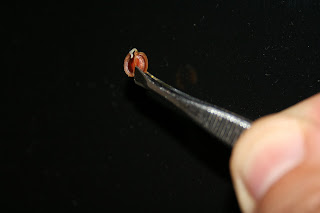My gander has been well and truly got by a letter in this week's GN by some no mark called Peter Snazell for a totally ridiculous attack on the NVS. The letter in full reads:
"I decided to join the NVS after finding lots of useful information on their website
(very true) . I wanted to grow vegetables that taste good, using organic
(yawn!) , wildlife-friendly methods and thought the NVS would teach me more
(it certainly can) .
However, I've since found out that the NVS seems to place its emphasis heavily on growing for showing
(yeah....so?). Yet the idea of producing huge but tasteless crops, using synthetic chemicals to ensure blemish-free plants, seems pointless to me
(your stupid beard seems pointless to me mate). And a look through the RHS Horticultural Show Handbook even tells me that cucumbers have to be green, so my 'Crystal Apple' fruits are no good, despite being the best tasting (taste is subjective mate...I bet your mum loves you but most people think you're a knob) .There is a huge surge of interest in growing your own veg and if you look at the wide range of people using allotments you'll see an assortment of ages and cultural backgrounds
(and I bet they all f***ing scatter when they see you coming!) . What they have in common
(apart from thinking you're a prick you mean?) is a desire to cultivate tasty, healthy produce that they can enjoy at family mealtimes. Many of these growers would find the methods used by many exhibitors completely alien to them
(asked them all have you? Twat!) .
Take for example, the onion growers who use concrete block beds, a 20ft greenhouse with constant temperature and artificial lighting (operating 24 hours a day), sodium lamps, heat blankets, gas boiler and electric fan system in their quest to produce onions up to 16lb. To me this is turning the joy of grow your own (GYO) gardening into an industrial complex,
(it's called dedication actually you wanker) , to say nothing of the amount of energy that's being consumed
(are we asking you to pay for it?) .
The majority of people dedicated to the GYO movement are not interested in this expensive, energy wasting
(only energy wasting being done is by GN printing crap from tits like you) and synthetic way of growing. Weren't allotments and veg showing originally about encouraging working people to live and eat healthily?
(they still f***ing were last time I looked!)The objectives of the NVS include 'to advance the education of the public in the cultivation and improvement of vegetables'. Do you think that the public believe that producing longer carrots or bigger onions is improving vegetables?
(course it twatting well is) Now celebrating its 50th year, the NVS should be looking to plug the increasing gap between growing to eat (for taste) and growing to show (for cosmetic size).
(All show veg is perfectly edible you uninformed tosspot)My village holds a produce show each August. However, every year it features the same names
(good growers you mean?) , the same out of season exhibits
(huh? They'd be f***ing daffodils I assume?) and yes, the same green cucumbers
(what colour should they be then?) . Wouldn't it be good to see a class especially for organically grown veg?
(ooo look Mildred...this bloke's grown wonderful fleabitten carrots) And for 'flavour' to be included on the judging criteria?
(errr....no!)Vegetable growing should be encouraged for the reasons that interest most vegetable growers
(should it? I didn't realise we were living in a dictatorship) - making use of current trends, not past ideas.
(Show growers are actually the most forward thinking and ingenious growers you'll find you arsehole) It's only when you have gained people's interest that you can lead them on to exhibiting. But please let's get back to the real roots of growing nutritious and tasty veg crops that grace our meal tables - rather than the show benches"
What an absolute unnecessary kick in the teeth to the NVS. This guy must be a right barrel of laughs down the pub of an evening. I for one know that the NVS is full of dedicated growers who bend over backwards to help the average grower and who help out in schools. This muppet misses the point entirely. The idea of a veg show is to put on a 'show' for the general public to marvel at. It is a marvellously British tradition that has been going on for 200 years. Who the f*ck would want to look at a bench full of scabby vegetables all cut to pieces in order for the judge to assess flavour. If it was a cookery demonstration fair enough but it aint. Snazell....feck off back into your organic orifice.













